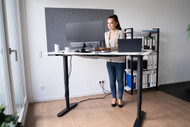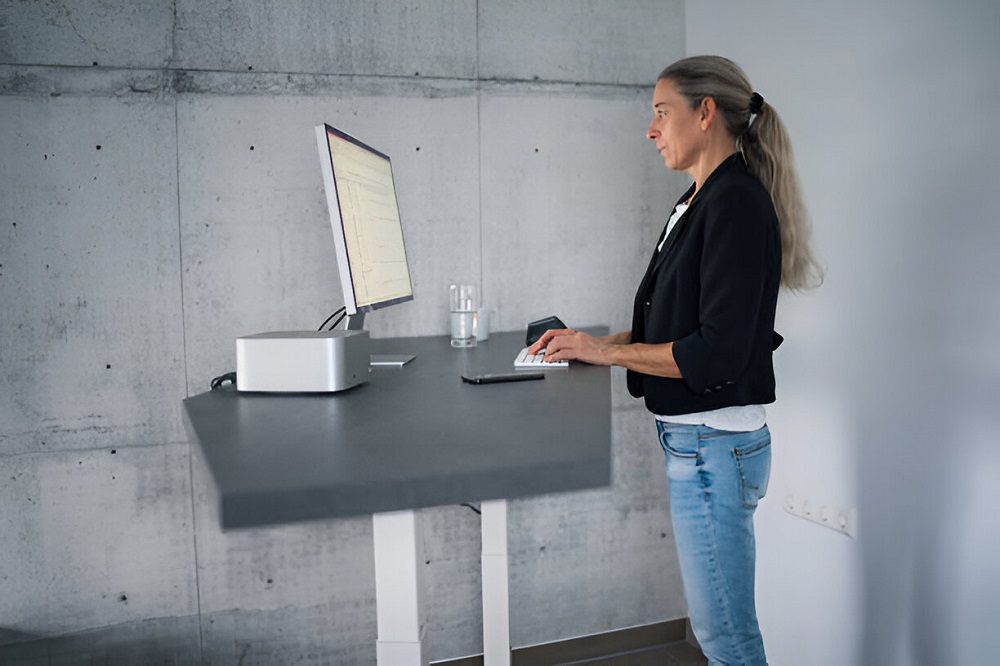Did you know that sitting for long hours every day can significantly increase your risk of high blood pressure and other serious health conditions?
Yes, standing desks are becoming increasingly common in modern workplaces as people seek ways to work while improving their health and well-being.
These innovative desks allow users to stand while working, offering a practical alternative to the traditional seated desk setup. Blood pressure, a measurement of the force of blood on the artery walls, can be significantly impacted by lifestyle decisions, such as how active or inactive we are.
Hypertension, often known as high blood pressure, is a common condition that increases the risk of heart disease, stroke, and other serious health issues.
Could standing desks be a simple yet effective tool for managing and lowering blood pressure?
This blog will explore this possibility, the potential benefits, and the science behind using these desks to promote better cardiovascular health.
Understanding Blood Pressure
- What is Blood Pressure?
Blood pressure is the force the blood exerts on the artery walls while the heart pumps blood throughout the body. It is expressed as two numbers: the diastolic pressure (the lower number) and the systolic pressure (the upper number), and it is measured in millimeters of mercury (mmHg).
Systolic pressure shows the pressure in the arteries throughout a heartbeat, whereas diastolic pressure measures the pressure between the heartbeat and the arteries. - Why is High Blood Pressure a Concern?
Blood pressure control is essential. For general health and well-being, hypertension or high blood pressure can cause major health problems, such as cardiovascular disease, heart disease, and stroke.
On the other hand, hypotension, or low blood pressure, can result in fainting, dizziness, and, in extreme situations, shock.
Standing Desk

Standing desks are becoming increasingly common as a countermeasure to the harmful consequences of extended sitting. They offer a healthier alternative for modern work environments.
At Onergon, we champion the benefits of standing desks, which include improved ergonomics, reduced back pain, and potentially lower blood pressure.
These desks, also known as stand-up desks, feature adjustable height settings, allowing users to alternate between sitting and standing throughout the day. This flexibility promotes movement, reduces sedentary time, and enhances overall health.
Modern designs available in these desks have user-friendly features like adjustable heights and built-in footrests, making them more ergonomic and comfortable.
How Do Standing Desks Lower Your Blood Pressure?
Being physically active decreases blood pressure by maintaining the health of your heart and blood vessels, which lowers the risk of stroke & heart disease.
Engaging in more physical activity should be considered appropriate if you have high blood pressure. But, before beginning any new workout, consult your physician or nurse if your blood pressure is 180/100 mmHg or higher.
Let's discuss these factors in detail-
1. Improves Blood Circulation and Heart Rate
When you stand up, your heart rate and blood circulation are boosted, strengthening your muscles and encouraging proper posture. This encourages better cardiovascular health and can lower blood pressure.
In fact, according to one study, cutting back on sitting to three hours a day would add two years to the typical American's life expectancy.
2. Reduces Body Pain
Compared to persons without discomfort, those experiencing low back pain for over two years had higher resting blood pressure levels. This is due to the nervous system's constant attempts to correct it, which eventually causes it to lose its capacity to control blood pressure.
Standing up and sitting appropriately can help ease back and neck pain and reduce blood pressure.
3. Helps with Weight Loss
Elevated body weight is associated with primary hypertension. If your weight is the cause of your elevated blood pressure, this helps you lose weight, which would lower your blood pressure.
Standing up increases your caloric expenditure by about 100 to 200 calories per hour.
If you have this kind of desk, you must try to get up and walk around. Here are some tips for maximizing calorie burn at a standing desk. By including exercises like walking, squatting, or stretching, you will burn more calories and lose weight at a desk.
4. Improves Mood
Long-term sitting has been associated with an increased risk of anxiety and depression, and stress is one of the main causes of hypertension.
A height-adjustable desk can help boost mood and overall well-being by keeping you actively involved and counteracting the negative effects of extended sitting.
How Sitting Can Affect Your Blood Pressure?

High blood pressure, or hypertension, is a major global health concern. Approximately 119.9 million adults in the US suffer from hypertension, according to a study by Million Hearts. The risk of kidney failure, heart disease, & stroke is greatly increased by this illness.
Long periods of sitting are strongly linked to an elevated risk of hypertension. There are probably a few reasons for the risk:
- Reduced Muscle Activity: Long-term sitting reduces muscle activity, which can impede the body's capacity to control blood sugar levels and insulin sensitivity. Consequently, elevated blood pressure may arise.
- Increased Blood Volume: Blood tends to pool in the legs when you sit, which causes a brief increase in blood volume. The heart must work harder to circulate blood throughout the body.
- Weight Gain: Another important risk factor for hypertension is weight gain, which is frequently associated with prolonged sitting.
How to Maximize the Benefits of Standing Desk?
If you are considering using these height-adjustable desks to lower your blood pressure, keep these aspects in mind.
- Balance is Key
Make an effort to alternate between standing & sitting during the working day. Experts advise switching up your posture every 30 to 60 minutes. - Invest in Proper Ergonomics
Make sure your desk's height is set correctly for the best possible posture. When standing, keep your elbows bent at a 90-degree angle. - Consider a Sit-stand Workstation
You can effortlessly go between sitting and standing throughout the day with a sit-stand workstation. - Stay Hydrated
Water consumption plays a major role in maintaining appropriate blood volume, essential for normal blood pressure. - Maintain a Healthy Lifestyle
A standing desk is but one element of the puzzle. For optimal cardiovascular health, combine it with a balanced diet, frequent exercise, and stress reduction techniques.
Conclusion
If you consider adding a standing desk to your workstation, it can be a simple but powerful method of improving your general health and reducing blood pressure. It provides a workable way to improve cardiovascular health and well-being by encouraging mobility, enhancing posture, and reducing inactive time.




